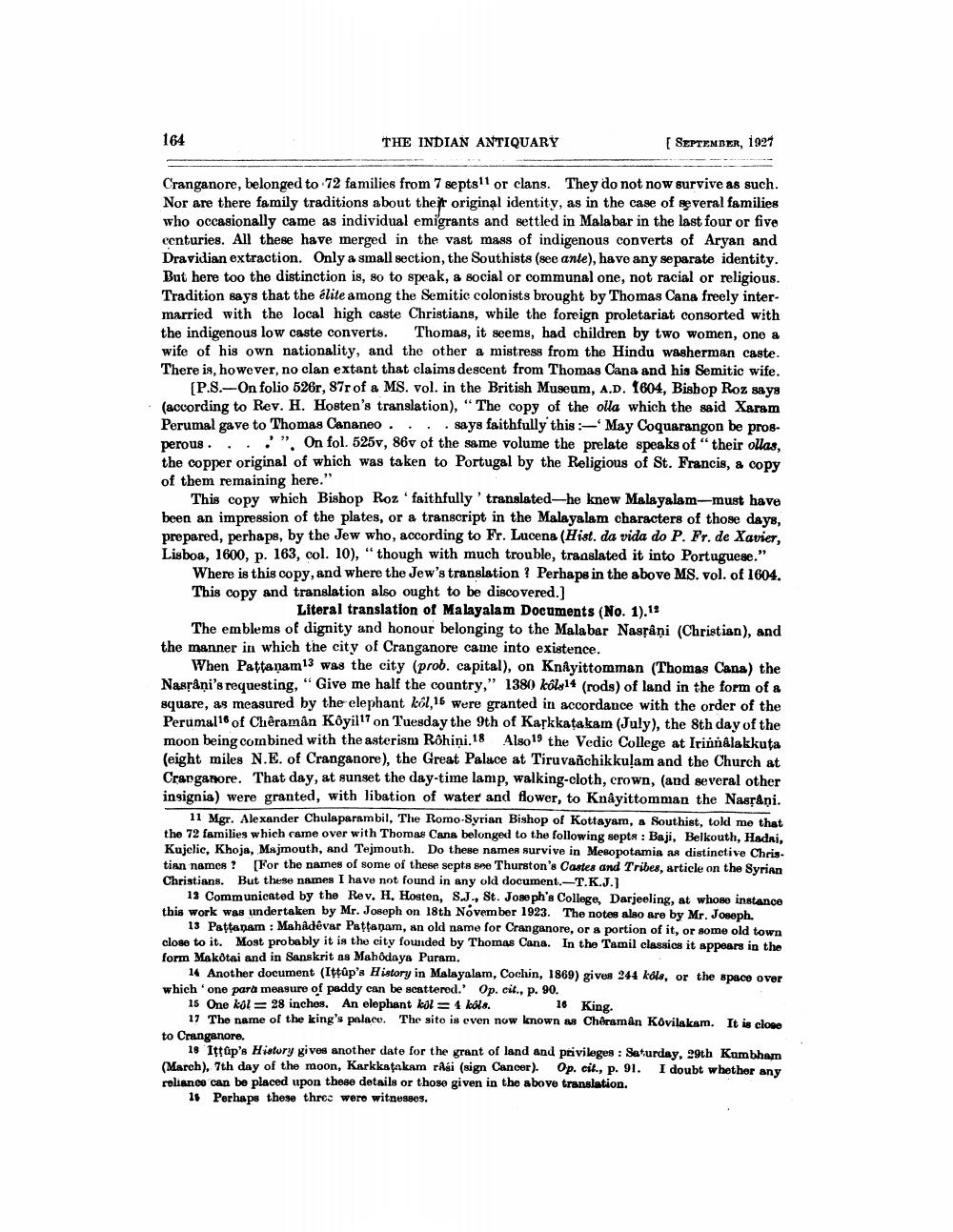________________
164
THE INDIAN ANTIQUARY
SEPTEMBER, 1921
Cranganore, belonged to 72 families from 7 septsil or clans. They do not now survive as such. Nor are there family traditions about their original identity, as in the case of several families who occasionally came as individual emigrants and settled in Malabar in the last four or five centuries. All these have merged in the vast mass of indigenous converts of Aryan and Dravidian extraction. Only a small section, the Southists (see ante), have any separate identity. But here too the distinction is, so to speak, a social or communal one, not racial or religious. Tradition says that the élite among the Semitic colonists brought by Thomas Cana freely intermarried with the local high caste Christians, while the foreign proletariat consorted with the indigenous low caste converts. Thomas, it seems, had children by two women, one a wife of his own nationality, and the other a mistress from the Hindu washerman caste. There is, however, no clan extant that claims descent from Thomas Cana and his Semitic wife.
(P.S.--On folio 526r, 87r of a MS. vol. in the British Museum, A.D. 1604, Bishop Roz says (according to Rev. H. Hosten's translation), “The copy of the olla which the said Xaram Perumal gave to Thomas Cananeo .... says faithfully this May Coquarangon be progperous....". On fol. 525v, 86v of the same volume the prelate speaks of their ollas, the copper original of which was taken to Portugal by the Religious of St. Francis, a copy of them remaining here."
This copy which Bishop Roz' faithfully 'translated-he knew Malayalam-must have been an impression of the plates, or a transcript in the Malayalam characters of those days, prepared, perhaps, by the Jew who, according to Fr. Lucena (Hist. da vida do P. Fr. de Xavier, Lisboa, 1600, p. 163, col. 10), “though with much trouble, translated it into Portuguese."
Where is this copy, and where the Jew's translation ? Perhaps in the above MS. vol. of 1604. This copy and translation also ought to be discovered.]
Literal translation of Malayalam Documents (No. 1).13 The emblems of dignity and honour belonging to the Malabar Nasråņi (Christian), and the manner in which the city of Cranganore came into existence.
When Pattanam 13 was the city (prob. capital), on KnAyittomman (Thomas Cana) the Nassäni's requesting, "Give me half the country," 1380) kólg14 (rods) of land in the form of a square, as measured by the elephant kôl, 16 Were granted in accordance with the order of the Perumal16 of Chêraman Köyill7 on Tuesday the 9th of Karkkatakam (July), the 8th day of the moon being combined with the asterism Rəhiņi.18 Also 19 the Vedic College at IrinnAlakkuta (eight miles N.E. of Cranganore), the Great Palace at Tiruvañchikkulam and the Church at Cranganore. That day, at sunset the day-time lamp, walking-cloth, crown, (and several other insignia) were granted, with libation of water and flower, to Knayittomman the Nasråņi.
11 Mgr. Alexander Chulaparambil, The Romo Syrian Bishop of Kottayam, a Southist, told me that the 72 families which came over with Thomas Cana belonged to the following septs : Baji, Belkouth, Hadai, Kuiclic. Khoja, Majmouth, and Tejmouth. Do these names survive in Mesopotamia as distinctive Chris. tian names? (For the names of some of these septs see Thurston's Castes and Tribes, article on the Syrian Christians. But these names I have not found in any old document.-T.K.J.]
13 Communicated by the Rev. H. Hosten, S.J., St. Joseph's College, Darjeeling, at whose instance this work was undertaken by Mr. Joseph on 18th November 1923. The notes also are by Mr. Joseph.
13 Pattanam : Mahadevar Pattanam, an old name for Cranganore, or a portion of it, or some old town close to it. Most probably it is the city founded by Thomas Cana. In the Tamil classics it appears in the form Makotai and in Sanskrit as Mahôdaya Puram.
14 Another document (Itap's History in Malayalam, Cochin, 1869) gives 244 kóle, or the space over which one para measure of paddy can be scattered.' Op. cit., p. 90. 15 One kol=28 inches. An elephant kell = 4 kóle.
16 King. 17 The name of the king's palace. The site is even now known as Chéraman Kovilakam. It is close to Cranganore.
19 Ittup's History gives another date for the grant of land and privileges : Saturday, 29th Kumbham (March), 7th day of the moon, Karkkankam rAsi (sign Cancer). Op. cit., p. 91. I doubt whether any reliance can be placed upon these details or those given in the above translation.
15 Perhaps these thres were witnesses.




